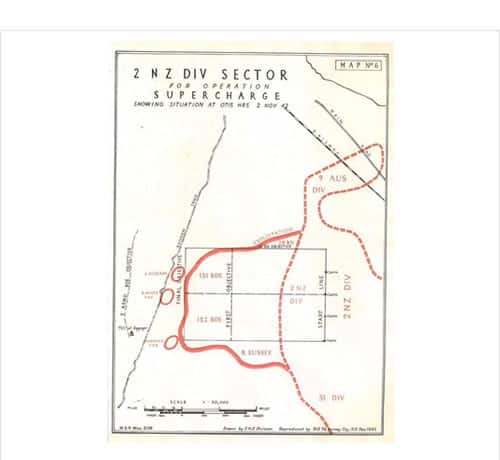The diary’s and accounts of Lt Karsten, WO2 JA Dyer and Cpl Frank Wallbank.
On 31 October, Lieutenant Colonel Farquhar received his orders:
The aim of the attack was once more to get X Corps through the enemy lines in order to force Rommel to fight on open ground, where the British forces with their superiority in weapons could destroy his panzer units, force him to use up his fuel reserves and cut off his supply lines.
The attack was to start with an artillery barrage that was to be even more intensive than the one during Operation Lightfoot. After this, two infantry brigades, supported by an armoured brigade consisting of Valentine and Matilda infantry tanks were to fight their way through the German and Italian defences while the sappers cleared three corridors through the minefields – one for each of the 9th Armoured Brigade’s three regiments, the 3rd King’s Own Hussars, the Royal Wiltshire Yeomanry and the Warwickshire Yeomanry.
The objective of the infantry was the “Grafton” Line, about 3,700 metres from the start positions. There, the three armoured regiments were to meet to push a further c.1800 metres forward to the important road between Sidi Abdel Rahman on the coast and Tel el Aqqaqir about 14 km inland. When this objective had been achieved, the 9th Armoured Brigade was to “keep the door open” so that the First Armoured Division could pass through and enter into battle with Rommel’s reserves.
Montgomery emphasized that “X Corps must get through this time – otherwise the whole campaign may end in failure”, and “9th Armoured Brigade must therefore reach their objective, whatever the cost, and having got there, must hold it until the arrival of 1st Armoured Division, even if this would involve 100 % casualties.”
After a preliminary move from Onsol to El Alamein Station on the evening of the 31st October, the Regiment rested and had final orders and conferences on the day of the 1st November.
The Army Commander’s plan was to switch the weight of his armoured attack from Miteriya to Aqqaquir and this time breakthrough was to be achieved even at the cost of 100% casualties of the spearhead units. The 151st and 152nd Infantry Brigades, supported by 23rd Armoured Brigade were to make an initial advance to within about three-quarter miles of the Sidi Rehnan Track, from there the 9th Armoured Brigade were to make a final puncture of the enemy anti-tank gun and field artillery positions to enable a passage to be cleared for X Corps to pass through into the open desert beyond.
It was a repetition of the general plan at Miteriya with different infantry units and a different part of the line.
Three Gaps were to be made in the minefields, the Warwicks were to pass through the Southern one, the Wilts through the centre and the 3rd Hussars through the Northern one.
The limit of the infantry objective was to be called GRAFTON, this was the 9th Armoured Brigades real start line.


